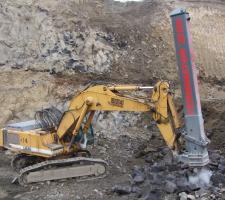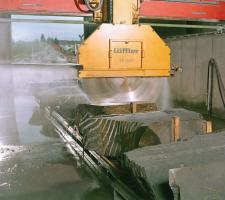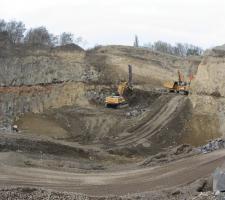In an historic and sensitive area of Germany, drill and blast in a local quarry became a no-go. A new system had to be found as Patrick Smith reports
Quarry operator Rainer Krings faced a stark choice: change his operation or face possible closure of part of his business.
For a man whose creed is “if there is a problem find a solution” the option was simple, and now his operation is in harmony with near neighbours and environmental rules.
To win basalt for aggregates his quarry in Mendig, near Cologne, Germany, had been using drill and blast. But in such a sensitive area, known locally as the Land der Vulkane (Land of the Volcanoes), it became untenable.
So after an extensive search he introduced the
Mendig is where fire-belching volcanoes covered everything with incandescent lava, and also home of the world-famous 900-year-old Benedictine Abbey Maria Laach by Lake Laach (Laacher See), the largest of all the Eifel region’s crater lakes, along with other major tourist attractions.
A journey to the sights of Mendig is an excursion to excavated volcanoes and mountain sides that reveal the history of the earth, says promotional information on the region.
Vault-like subterranean lava rock chambers at a depth of 32m and stretching for 3km below the town of Mendig are said to be unique throughout the world.
“When the last volcano eruption happened 13,000 years ago, the area was covered in a 20m deep shift of pumice [a lava rock full of bubble holes]. That eruption was ten times bigger than the Mount St Helens, which erupted in Washington state, USA, in 1980,” says Krings.
“Chambers under the area were caused from the Middle Ages onwards when material was taken away to be used for mill stones. These run under the town of Mendig.”
Mendiger Basalt is one of a number of quarries in the region and is in effect two quarries in one. It produces high quality, world-renowned natural stone products using materials from its lava basalt upper layer, and these have been used in many projects worldwide including the 2012 London Olympic Games, and aggregates from the lower layer.
The group owns five quarries (four with basalt lava), and Mendiger Basalt, the biggest, was started by Krings and his late father-in-law, entrepreneur H W Schmitz in 1992. All the quarries are within a half-hour drive of Mendig.
“I studied economics and went into banking but I said I wanted to be an entrepreneur and my father-in-law, who was already producing quarried material, suggested that we open this quarry and install a cutting factory for the stone.
“The first production was in 1994 at this quarry. It took two years to get the necessary permissions. Today you wait at least ten years for permission,” says Krings.
“Step by step it got bigger and in 1996 we established this fabrication plant here. Today this cutting factory is well known all over the world.
“The lava basalt is a special material because it has holes in it.
Architects like it and in 1995 we won our first international contract for the Museum of Modern Art in Vienna, Austria. That was our door-opener for new projects.
“People say it is difficult to polish lava basalt but after a visit to Verona in Italy we found it is possible. Through the polishing you can play with the colours.
“I bought a polishing line and run 60% of our slabs as high quality finish.”
While the material used in the natural stone cutting factory is teased from the face using a ripper tooth on a 100tonne excavator, other material is now broken out using a Terminator DX1800 with an energy punch of 180,000 joules.(Terminator is a trademark of Terminator IP SA)
“In the face only 30% of the material is good for cutting, and after winning that there is an area of material beneath that you cannot use for cutting,” says Krings.
“Basalt lava material is 2.3tonnes/m³ while the other basalt material is 3tonnes/m³.
“We started in 1997-98 with the production of bulk material for aggregates, and this was because we had a big contract for the high-speed ICE train between Hamburg and Munich. We supplied a total of 300,000tonnes of material.
“My idea was to buy a mobile plant. We started with that producing 0-100mm material and then we bought a cone crusher and then a screen and for normal material we were getting only €5/tonne. If you have high quality grade you get €5-12/tonne and we started to get better production and today we do 250,000-300,000tonnes per year of high quality product.
The mobile plant has been changed for a static plant because the material is easily transported from the face to the start of crushing operations where 0-2mm/2-5mm/5-8mm/8-11mm and 11-22mm make up most of the aggregates produced.
“We were gaining material after drilling and blasting, a system which has its advantages and problems. Quarries have to be closed through the proceedings and you have to have a good drilling machine,” says Krings.
“At the end of the day it was a problem because the nearest houses to our quarry are only 200m away and they are also sitting on the Mendig caverns and residents were worried about the blastings we had here.
“Two years ago we had a local election and after this the authorities stopped us blasting and said we must change our system.
“I looked for solutions and Googled various systems from Korea and Japan and
The DX Series Terminator has been developed over seven years by business partners Ian Dawson, and Angus Robson who is based in New Zealand. Six years ago they employed technical manager Guillaume Dannemark and he oversees production at the company’s plant in Waimes, Belgium, and also supervises the installation of hammers sold worldwide, particularly in Africa, Russia and the Middle East.
“The Terminator works on gravity. It is a simple concept but a complex machine to design and manufacture requiring a wide variety of disciplines in design and metallurgy” says Ian Dawson.
“To us an equally important element of production is that all the components are sourced from specialist companies in their field within 20km of our depot at Waimes.”
The Terminator at Mendig weighs 10.5tonnes; is 10.5m high; the point is 270mm in diameter and offers 1.3m of penetration into the rock.
“One hit is equivalent to about 18grammes of explosive which is what the French EDF told me.
“At Mendiger Basalt the Terminator is attached to a
Instead we attach a girdle system, which can attach to any excavator in the 65-75tonne range, by changing the pins and bushings. We don’t have the added weight of a mounting plate and keep the hammer as near to the excavator as possible. It also allows us to use the bucket cylinder breakout force to lever broken rock from the face.” says Dawson.
A standard hammer line from the excavator at about 250bar pressure using 220litres/minute activates a hydraulic cylinder which, when retracted, pulls a strap through three pulleys. This lifts a weight and it is then dropped onto the chisel and this hammers into the rock. As the hammer chisel becomes blunt it can be easily rebuilt with weld.
Guillaume Dannemark notes: “One of the most important things we did with this hammer was to make the tip of the chisel weldable. It takes about an hour, can be done as often as needed, and greatly reduces the cost per tonne of extraction with the Terminator hammer”.
“As the chisel penetrates the rock some 1.3-1.5m
it causes micro-cracking. As progression is made on the bench, which is about 4m high, rock becomes easier to extract. Our hammers break and extract by shock, not vibration, and penetrate both rock and concrete, shattering the material about 2m² around and beneath the impact penetration area of the point.”
Rocktec also produces the 6.5tonne DX700 to be fitted on carriers with a minimum weight of 33tonnes, and this generates 70,000 joules per hit, once every five seconds.
Depending what is being worked on the Terminator DX1800’s noise level is between 90-92dB at about 30m, but with further testing it hoped to reduce this by a further 5dB.
“No grease is required on the Terminator and maintenance can be done without a big workshop says Guillaume Dannemark.
While the Terminator is now established in the quarry, Rainer Krings wanted to be sure it would deliver on productivity.
“Initially my workers said that for extraction we had to use drill and blast, and I said that we could not carry on in the old ways,” says Krings.
CRUSHING1 x Terminator DX1800 hammer
1 x Skoda double-toggle jaw crusher
1 x Lokomo G2511 (Metso) cone crusher
1 x Lokomo G1010 cone crusher
1 Lokomo G611 cone crusher
EXCAVATOR1 x Liebherr 982
1 x Liebherr 974 with Terminator
1 x Liebherr 964
1 x Doosan DX 255
1 x Komatsu PC 240
WHEELED LOADER1 x Doosan DL 400
1 x Kaelble SL 18F
1 x Kaelble SL 26 2 units
DUMP TRUCKS3 x Kaelble K 33
4 x Kaelble KV 25
FORK LIFT TRUCKS1 x Linde H30
2 x Linde H35
2 x Linde H45
2 x Linde H50
“In a crushing plant you must have 1,000tonnes/day, and while we looked at alternatives, I asked Ian Dawson about the Terminator. We looked at the system and thought we must try it.
“I said it would be possible to use the Terminator and I had the hammer for a limited test period and in November 2010 we made our first hit in a quarry that was not designed for working with a hammer.
“I said to Ian that I would keep the hammer if we got 1,000tonnes/day, and we did. I decided to keep the hammer and bought the big Liebherr 974 excavator. An additional advantage is that the Terminator doesn’t damage the excavator with shock or vibration. None is communicated into the excavator.
“Since November 2010 we have had no blastings and production last year was increased by 20%. It was a big risk but we redesigned our quarry and on good days the hammer will do 300tonnes/hour. As for the costs, the hammer is competitive with drill and blast.”
The Mendiger Basalt quarry covers some 25 hectares; has over 45 employees and operates a fleet which also includes Liebherr 982, Liebherr 964, Doosan DX 255 and
At the quarry, rock for aggregates is loaded onto one of the company’s seven Kaelble dump trucks, with loading capacities of 30-35tonnes, using the Liebherr 964 excavator and the material is then taken to a feeder to be put through a 3,000mm x 1,500mm Breuer pre-screen before moving to a Skoda 1,200mm x 1,000m double-toggle jaw crusher.
It is delivered via conveyor to a Lokomo G2511 (
“It then goes to the first screen, 5,000mm x 1,600mm and this separates 0-8mm, 8-11mm and 11-35mm material. The 11-35mm material goes to another Lokomo crusher, a G611, which goes in a circle back to the screen,” says Krings.
A 6,500mm x 2,000mm screen separates out 0-2mm, 2-5mm and 5-8mm. The 0-2mm goes to a rubber-type screen and this takes out dust from the material, which is important for asphalt production: it has to have less than 10% dust in it.
“This quarry has another 30 years for producing natural stones but for aggregates material this will last 50 years,” says Krings


















